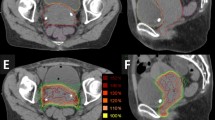Purpose:
To describe relative skin dose estimations and their impact on cosmetic outcome in interstitial multicatheter accelerated partial-breast irradiation (APBI).
Patients and Methods:
Between April 2001 and January 2005, 105 consecutive patients with early breast cancer were recruited in Erlangen, Germany, for this substudy of the German-Austrian APBI phase II trial. 51% (54/105) received pulsed-dose-rate (PDR), and 49% (51/105) high-dose-rate (HDR) brachytherapy. Prescribed reference dose for HDR brachytherapy was 32 Gy in eight fractions of 4 Gy, twice daily. Prescribed reference dose in PDR brachytherapy was 49.8 Gy in 83 consecutive fractions of 0.6 Gy every hour. Total treatment time was 3–4 days. With a wire cross on the skin surface during the brachytherapy-planning procedure the minimal, mean and maximal relative skin doses (SDmin%, SDmax%, SDmean%) were recorded. Endpoint of this evaluation was the cosmetic outcome in relation to the relative skin doses.
Results:
Median follow-up time was 38 months (range, 19–65 months). Cosmetic results for all patients were excellent in 57% (60/105), good in 36% (38/105), and fair in 7% (7/105). The SDmin% (27.0% vs. 31.7%; p = 0.032), SDmean% (34.2% vs. 38.1%; p = 0.008), and SDmax% (38.2% vs. 46.4%; p = 0.003) were significantly lower for patients with excellent cosmetic outcome compared to patients with a suboptimal outcome. SDmean% (37.6% vs. 34.2%; p = 0.026) and SDmax% (45.4% vs. 38.2%; p = 0.008) were significantly higher for patients with good cosmetic outcome compared with the patients with excellent results.
Conclusion:
The appraisal of skin doses has been shown to be relevant to the achievement of excellent cosmetic outcome. Further investigations are necessary, especially on the basis of CT-based brachytherapy planning, to further improve the treatment results of multicatheter APBI.
Ziel:
Entwicklung einer Methode zur Abschätzung von relativen Hautdosen bei der akzelerierten Teilbrustbestrahlung (APBI) in interstitieller Multikathetertechnik und Untersuchung des Einflusses der ermittelten Hautdosen auf das kosmetische Ergebnis.
Patienten und Methodik:
Zwischen 04/2001 und 01/2005 wurden 105 Patientinnen mit einem brusterhaltend operierten, prognostisch günstigen Mammakarzinom in diese Substudie der Deutsch-Österreichischen Teilbrustbestrahlungsstudie (Phase II) eingebracht. 51% (54/105) erhielten eine Pulsed-Dose-Rate-(PDR-) und 49% (51/105) eine High-Dose-Rate-(HDR-)Brachytherapie. Die HDR-Brachytherapie erfolgte mit acht Fraktionen à 4 Gy bis 32 Gy, zwei Fraktionen pro Tag. Die PDR-Brachytherapie-Dosis betrug 49,8 Gy mit 83 stündlichen Pulsen à 0,6 Gy. Die Gesamtbehandlungszeit betrug 3–4 Tage. Mit Hilfe eines auf die Hautoberfläche aufgeklebten Drahtkreuzes wurden die relativen minimalen, mittleren und maximalen Hautdosen (SDmin%, SDmean%, SDmax%) beschrieben. Endpunkt der Analyse war das kosmetische Ergebnis in Abhängigkeit von den relativen Hautdosen.
Ergebnisse:
Die mediane Nachbeobachtungszeit betrug 38 Monate (19–65 Monate). Das kosmetische Ergebnis war sehr gut in 57% (60/105), gut in 36% (38/105) und mäßig in 7% (7/105) der Fälle. Die relativen Hautdosen SDmin% (27,0% vs. 31,7%; p = 0,032), SDmean% (34,2% vs. 38,1%; p = 0,008) und SDmax% (38,2% vs. 46,4%; p = 0,003) waren in der Gruppe der Patientinnen mit sehr gutem kosmetischen Ergebnis signifikant niedriger als bei den übrigen Patientinnen mit suboptimalem Ergebnis. SDmean% (37,6% vs. 34,2%; p = 0,026) und SDmax% (45,4% vs. 38,2%; p = 0,008) waren bei Patientinnen mit guter Kosmetik signifikant höher als bei sehr gutem Ergebnis.
Schlussfolgerung:
Es konnte erstmals für die interstitielle Multikatheter-APBI gezeigt werden, dass die an der Hautoberfläche deponierte Strahlendosis die Wahrscheinlichkeit für das Erreichen eines sehr guten kosmetischen Ergebnisses mit beeinflusst. Weiterführende Untersuchungen sind erforderlich, insbesondere auf der Basis der CT-gestützten Brachytherapieplanung, um das kosmetische Ergebnis nach interstitieller Multikatheter-APBI noch weiter zu optimieren.
Similar content being viewed by others
Author information
Authors and Affiliations
Corresponding author
Rights and permissions
About this article
Cite this article
Ott, O.J., Lotter, M., Sauer, R. et al. Accelerated Partial-Breast Irradiation with Interstitial Implants. Strahlenther Onkol 183, 426–431 (2007). https://doi.org/10.1007/s00066-007-1738-6
Received:
Accepted:
Issue Date:
DOI: https://doi.org/10.1007/s00066-007-1738-6




